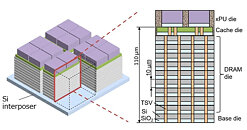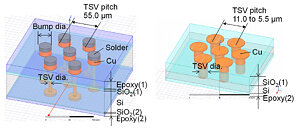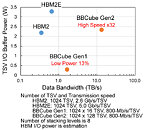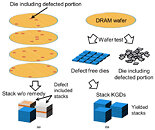TheLostSwede
News Editor
- Joined
- Nov 11, 2004
- Messages
- 17,563 (2.40/day)
- Location
- Sweden
| System Name | Overlord Mk MLI |
|---|---|
| Processor | AMD Ryzen 7 7800X3D |
| Motherboard | Gigabyte X670E Aorus Master |
| Cooling | Noctua NH-D15 SE with offsets |
| Memory | 32GB Team T-Create Expert DDR5 6000 MHz @ CL30-34-34-68 |
| Video Card(s) | Gainward GeForce RTX 4080 Phantom GS |
| Storage | 1TB Solidigm P44 Pro, 2 TB Corsair MP600 Pro, 2TB Kingston KC3000 |
| Display(s) | Acer XV272K LVbmiipruzx 4K@160Hz |
| Case | Fractal Design Torrent Compact |
| Audio Device(s) | Corsair Virtuoso SE |
| Power Supply | be quiet! Pure Power 12 M 850 W |
| Mouse | Logitech G502 Lightspeed |
| Keyboard | Corsair K70 Max |
| Software | Windows 10 Pro |
| Benchmark Scores | https://valid.x86.fr/yfsd9w |
Scientists at the Tokyo Institute of Technology have developed a new type of stacked or 3D DRAM that the researchers call Bumpless Build Cube 3D or BBCube 3D, which relies on Through Silicon Vias or TSVs to connect the DRAM dies. This is a different approach to HBM which relies on micro bumps to connect the layers together and the Japanese scientists are saying that their bumpless wafer-on-wafer solution should allow not only for an easier manufacturing process, but more importantly, improved cooling, as the TSVs can channel the heat from the DRAM dies down into whatever substrate the BBCube 3D stack is finally mounted onto.
If that wasn't enough, the researchers believe that BBCube 3D will be able to deliver higher speeds than HBM courtesy of a combination of the TSVs being relatively short and "high-density signal parallelism". BBCube 3D is expected to deliver up to a 32 fold increase in bandwidth compared to DDR5 memory and a four fold increase compared to HBM2E memory, while at the same time, drawing less power. The research paper goes into a lot more details for those interested at taking a closer look at this potentially revolutionary shift in DRAM assembly. However, the question that remains unanswered is if this will end up as a real world product some time in the near future, which is all based on how manufacturable BBCube 3D memory will be.





View at TechPowerUp Main Site | Source
If that wasn't enough, the researchers believe that BBCube 3D will be able to deliver higher speeds than HBM courtesy of a combination of the TSVs being relatively short and "high-density signal parallelism". BBCube 3D is expected to deliver up to a 32 fold increase in bandwidth compared to DDR5 memory and a four fold increase compared to HBM2E memory, while at the same time, drawing less power. The research paper goes into a lot more details for those interested at taking a closer look at this potentially revolutionary shift in DRAM assembly. However, the question that remains unanswered is if this will end up as a real world product some time in the near future, which is all based on how manufacturable BBCube 3D memory will be.





View at TechPowerUp Main Site | Source





